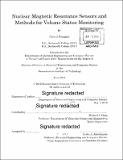Nuclear magnetic resonance sensors methods for volume status monitoring
Author(s)
Frangieh, Chris J.(Christopher John)
Download1124923763-MIT.pdf (7.434Mb)
Other Contributors
Massachusetts Institute of Technology. Department of Electrical Engineering and Computer Science.
Advisor
Michael J. Cima.
Terms of use
Metadata
Show full item recordAbstract
Portable, non-invasive sensors of tissue fluid distribution would aid in diagnosis of fluid volume disorders and inform therapeutic decisions across diverse patient populations. Existing techniques are inaccurate, invasive, or easily confounded by patient physiology. Single-sided magnetic resonance (MR) devices could provide a portable, low-cost platform for localized measurements of fluid distribution. This thesis demonstrates a single-sided MR sensor that can quantify fluid distribution of heterogeneous samples via depth-resolved, diffusion-weighted, multicomponent T2 relaxometry. Validation using synthetic tissue phantoms, ex vivo tissue samples, and an in vivo edema model is presented. Estimation of tissue fractions in heterogeneous samples with 2% error and tissue layer thickness with 0.1 mm error is demonstrated. The sensor can identify onset, progression, and recovery of muscle edema despite the presence of a confounding subcutaneous tissue layer. These methods can provide point-of-care diagnostics for fluid distribution disorders such as end-stage renal disease and dehydration.
Description
Thesis: S.M., Massachusetts Institute of Technology, Department of Electrical Engineering and Computer Science, 2019 Cataloged from PDF version of thesis. Includes bibliographical references (pages 47-51).
Date issued
2019Department
Massachusetts Institute of Technology. Department of Electrical Engineering and Computer SciencePublisher
Massachusetts Institute of Technology
Keywords
Electrical Engineering and Computer Science.